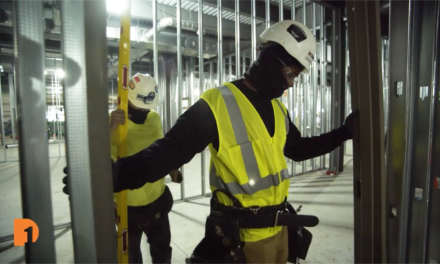Taking a look around Michigan’s major cities, design is everywhere. The creativity of designers can be seen throughout Michigan in the clothes we wear, the architecture of our cities and the cars we drive, but still, globally Detroit isn’t recognized for having a strong design industry. How can Michigan develop more design jobs across the state, and prepare young designers for future design jobs?
RELATED: Check out One Detroit’s extensive Future of Work coverage here
From One Detroit’s Future of Work virtual town hall, “Michigan Redesigned,” Future of Work host Will Glover talks with DESIGNCONNECT Founder and Executive Director Jocelyn Chen, Olga Stella, the vice president of strategy & communications at College for Creative Studies and the executive director of Design Core Detroit, and legendary footwear designer and PENSOLE Lewis College of Business & Design Founder Dr. D’Wayne Edwards about the design jobs currently available in Michigan, the investments Michigan needs to create and build a design network that generates new design jobs, and how to attract stakeholders, like garment manufacturers, reputable galleries and media partners, to Michigan to help bolster the state’s budding design industry.
Full Transcript:
Will Glover, Assoc. Producer, One Detroit: Design a word used in virtually every industry, a category so integral to our lives, it often goes completely unnoticed. Could you give us an example of something that is designed well and something that is designed poorly that we might interact with on our daily, day-to-day lives?
Olga Stella, VP of Strategy and Communications, College for Creative Studies: Sure. So, I like to use examples of inclusive design. And so, one example is sidewalk ramps. Those are designed really well, because they’re designed for everyone. And originally, they were designed for people in wheelchairs. But if you’re a parent with a stroller or you’re a delivery man with a pushcart, it creates benefits in all of our lives in navigating public space.
Something that is often designed poorly, and this is one of Don Norman’s favorite examples, he’s a well-known designer, he’s written books on functional design, good design, is doors and buildings. And do you push them? Do you pull them? How do I use the door? Right. If you can’t figure out intuitively how to use something, it’s probably not designed well.
Will Glover: What kind of education levels need to be attained to even consider going into design? And Jocelyn, I’ll pose this question to you because you’re kind of building the pipeline to get kids into this space.
Jocelyn Chen, Founder & Executive Director, DESIGNCONNECT: The obvious choice, I think that the most visible choice, is a four-year degree in arts college, like College for Creative Studies. But there are just many different pathways to design career. And that’s what we want to make students and parents aware.
There are two-year associate degrees. You can be self-taught. And even out of high school, if we provide the right education in high school, kids can start their own business. And we also have Pensole Lewis College of Design Business that provides more, continuing education to students who may not have the college degree.
And one example of associate degree is the clay sculpting degree at Macomb Community College. I came from an automotive design background, so I know that in the automotive industry, clay sculptors are in high demand and a two-year associate degree can lead to a very, very stable, well-paying job in the automotive industry.
So we want to make that known. It’s not just the four-year degree. Pathways, there are multiples.
Will Glover: Design is a field that requires all sorts of skills that thrust some into the spotlight of celebrity, while others like the inventor of the modern anti-lock brakes on your car, Mario Palazzetti, remain mostly invisible yet ever present. This is to say that the skills required to be a designer vary. But according to one of history’s most prominent footwear designers, Dr. D’Wayne Edwards, some things are necessary, no matter the discipline.
Dr. D’Wayne Edwards, Founder, Pensole Lewis College of Business and Design: Good design is something you don’t even recognize, right? Because it’s so intuitive and it just functions the way you need it to function. And we really only recognize bad design because something went wrong or a problem happened. But I would say common sense, through the lens of, we’re ultimately problem solvers and if we’re connected to the consumer that we’re trying to solve that problem for, then we have to become those people that we’re creating products for. With the idea of making their lives easier and more intuitive.
The thing that we look for most at the college is, really, passion. Because I don’t think the world needs more designers. I think that the world needs better designers. And I wish that people who took up the idea of trying to become a designer was really passionate about it. Because through that passion comes the tireless days and nights. But it also, you know, what comes from that are some amazing solutions along the way.
Will Glover: What would it look like if there was more emphasis, more investment, more focus on this particular area?
Olga Stella: Well, as I mentioned at the start, we consider this, as Jocelyn was also explaining, it’s applied, right? It’s creative problem-solving. And if we had more of an emphasis, middle school and high school throughout the state of Michigan, I think we’d just have a more competitive economy. We’d have more people, more young people ready to enter the workforce regardless of what they’re doing, really understanding some of these design concepts.
Olga Stella: I think many of the viewers are familiar with the concepts of design thinking and the way that that’s really changed the business world. Well, I mean, that’s fundamentally the parts of the design process, right? Identifying and conceptualizing what a problem is. Ideating and being creative about what different solutions are. Prototyping and testing those potential solutions, and then iterating that. Like what company, what business doesn’t need people, young people who can do those things? Regardless of whether or not they have the technical skills that are absolutely essential to be a professional designer. But all of us need more creative problem solvers in the workforce.
When Detroit was designated UNESCO’s City of Design, we did a big economic study. And one of the things that we found was that while only 1% of the industries and 5% of the workforce in 2018 were classified as design. When you draw the connection to all the other businesses, all the other industries, that small but mighty group of creative problem solvers were powering over 20% of the rest of our regional economy.
So the impact of designers and these kinds of creative problem solvers is far, far greater than their volume. To D’Wayne’s point, we don’t need thousands, but we need to make sure that we don’t lose this strength as a region, as a state, because that is ultimately what has powered Michigan’s success over the last hundred years.
Stay Connected:
Subscribe to One Detroit’s YouTube Channel & Don’t miss One Detroit Mondays and Thursdays at 7:30 p.m. on Detroit Public TV, WTVS-Channel 56.
Catch the daily conversations on our website, Facebook, Twitter @DPTVOneDetroit, and Instagram @One.Detroit
View Past Episodes >
Watch One Detroit every Monday and Thursday at 7:30 p.m. ET on Detroit Public TV on Detroit Public TV, WTVS-Channel 56.




